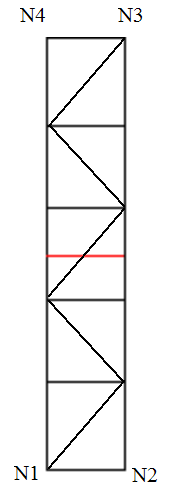9. H modeling#
This modeling is based on the F modeling.
The type of element chosen for the mesh is the only difference between these two models.
9.1. Characteristics of the mesh#
Each QUAD4 mesh of the F modeling is broken down into 2 TRIA3 for the H model.
Thus the structure is discretized into 10 finite elements TRIA3.
The nodes on either side of the interface are enriched nodes, so the triangles contained in the three central cells of the F modeling that have such nodes are also enriched. Only the triangles contained in the two extreme quadrilaterals of the F model are conventional meshes that have only classical nodes.
It is therefore possible to impose boundary conditions on the extreme meshes in the usual way.

Figure 9.1-a : H mesh
9.2. Boundary conditions#
The nodes on the lower face are embedded and the nodes on the upper face are forced to move:
Underside (Knots \(\mathrm{N1}\), \(\mathrm{N2}\)): \(\mathrm{DX}=0\), and \(\mathrm{DY}=0\)
Upper side (Knots \(\mathrm{N3}\), \(\mathrm{N4}\)): \(\mathrm{DX}=0\) and \(\mathrm{DY}=\mathrm{uy}\)
9.3. Analytical resolution#
The solution of such a problem is of course still obvious: all the movements following \(x\) are zero, all the movements following \(y\) below the level set are zero and all the movements following \(y\) above the level set are equal to the displacement imposed \({u}_{y}\) at the top of the structure.
9.4. Tested sizes and results#
The displacement values are tested after convergence of the iterations of the operator STAT_NON_LINE. We check that we find the values determined in [§9.3].
Identification |
Reference |
Tolerance |
\(\mathit{DX}\) for all nodes just below the interface |
0.00 |
1.0E-16 |
\(\mathit{DY}\) for all nodes just below the interface |
0.00 |
1.0E-16 |
\(\mathit{DX}\) for all nodes just above the interface |
0.00 |
1.0E-16 |
\(\mathit{DY}\) for all nodes just above the interface |
1.0E-6 |
1.0E -9% |
To test all the nodes at once, we test the MINIMUM and the MAXIMUM of the column.
9.5. Comments#
To test all the nodes at once, we test the MINIMUM and the MAXIMUM of the column.